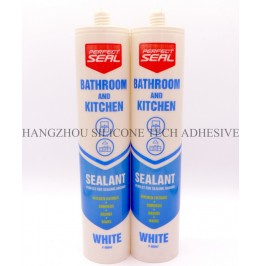Sealants are critical for creating waterproof barriers in bathrooms, kitchens, and other moisture-prone areas. However, using products with compromised packaging can lead to severe consequences, ranging from structural damage to health risks. Below are detailed explanations of the hazards associated with damaged sealant containers.

Sealants rely on precise chemical formulations to cure properly and adhere to surfaces. When packaging is damaged, air, moisture, or contaminants can infiltrate the container, altering the chemical balance. For example, exposure to humidity may cause premature curing inside the tube, rendering the sealant unusable. Similarly, air ingress can lead to oxidation, weakening the adhesive properties and reducing effectiveness.
Chemical instability also increases the risk of uneven curing. Partially cured sealants may remain tacky or shrink after application, creating gaps that allow water penetration. In extreme cases, degraded sealants can emit harmful fumes during curing, posing health risks to occupants.
Damaged packaging often results in sealants that fail to bond correctly to surfaces. Contaminants like dust, dirt, or mold spores entering the container can interfere with adhesion, causing the sealant to peel or crack over time. This is particularly problematic in high-moisture environments, where weak bonds accelerate deterioration.
Additionally, compromised sealants may lack the flexibility needed to withstand temperature fluctuations and structural movement. As a result, even minor shifts in building materials can cause the sealant to split, leaving vulnerable gaps. Over time, this leads to costly repairs and potential water damage to underlying structures.
Using sealants from damaged containers can expose users to toxic substances. Many sealants contain volatile organic compounds (VOCs) and other chemicals that are harmless when properly sealed but hazardous when released due to packaging failure. Inhaling these fumes during application or curing can cause respiratory irritation, headaches, or dizziness.
Moisture ingress into damaged packaging creates an ideal environment for mold and bacteria to thrive. When such contaminated sealants are applied, they introduce pathogens directly into living spaces. Mold spores can trigger allergies or asthma attacks, while bacteria may pose infection risks, especially in homes with vulnerable individuals like children or the elderly.
Contaminated sealants also emit musty odors that persist long after application, degrading indoor air quality. Removing mold-infested sealants later requires extensive cleanup and may necessitate professional remediation services.
The primary purpose of sealants is to prevent water damage, but using compromised products achieves the opposite. Leaks caused by failed sealants can rot wood, corrode metal, and weaken concrete foundations. Over time, this structural damage becomes expensive to repair, often requiring full replacement of affected materials.
Damaged sealants demand frequent reapplication, driving up long-term costs. Poor adhesion means sealants must be scraped off and replaced more often, consuming time and labor. In commercial settings, such as hotels or hospitals, frequent repairs disrupt operations and inconvenience occupants, leading to indirect financial losses.
In cases where water damage affects neighboring properties or shared infrastructure, using substandard sealants due to damaged packaging can result in legal disputes. Property owners may be held liable for negligence if they fail to use reliable materials, leading to costly settlements or insurance claims.
Improperly stored or damaged sealant containers contribute to environmental pollution. Leaking chemicals can seep into soil and groundwater, contaminating ecosystems. Disposing of compromised sealants incorrectly—such as pouring them down drains—further harms waterways and wildlife.
Damaged packaging often forces users to discard entire containers of sealant, even if only a small portion is affected. This leads to unnecessary waste, as unused material ends up in landfills. Sustainable practices, such as storing sealants in airtight containers and inspecting packaging regularly, help minimize environmental harm.
By understanding these risks, users can prioritize packaging integrity when selecting sealants, ensuring safety, durability, and environmental responsibility.
Copyright 2019 by Hangzhou Silicone Tech Adhesive Co., Ltd. All rights reserved.
Bathroom Sealant | Acrylic Sealant | Dow Corning 795 | Aquarium Sealant | Dow Corning 732 | Clear Silicone Sealant | Polysulfide Sealant | Glazing Sealant | Mirror Sealant | IG Sealant
Powered by Onepound